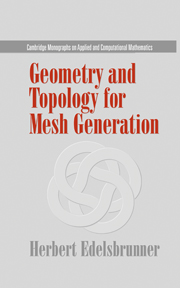4 - Surface simplification
Published online by Cambridge University Press: 03 October 2009
Summary
This chapter describes an algorithm for simplifying a given triangulated surface. We assume this surface represents a shape in three-dimensional space, and the goal is to represent approximately the same shape with fewer triangles. The particular algorithm combines topological and numerical computations and provides an opportunity to discuss combinatorial topology concepts in an applied situation. Section 4.1 describes the algorithm, which greedily contracts edges until the number of triangles that remain is as small as desired. Section 4.2 studies topological implications and characterizes edge contractions that preserve the topological type of the surface. Section 4.3 interprets the algorithm as constructing a simplicial map and establishes connections between the original and the simplified surfaces. Section 4.4 explains the numerical component of the algorithm used to prioritize edges for contraction.
Edge contraction algorithm
A triangulated surface is simplified by reducing the number of vertices. This section presents an algorithm that simplifies by repeated edge contraction. We discuss the operation, describe the algorithm, and introduce the error measure that controls which edges are contracted and in what sequence.
Edge contraction
Let K be a 2-complex, and assume for the moment that |K| is a 2-manifold. The contraction of an edge ab ∈ K removes ab together with the two triangles abx, aby, and it mends the hole by gluing xa to xb and ya to yb, as shown in Figure 4.1. Vertices a and b are glued to form a new vertex c.
- Type
- Chapter
- Information
- Geometry and Topology for Mesh Generation , pp. 68 - 88Publisher: Cambridge University PressPrint publication year: 2001



